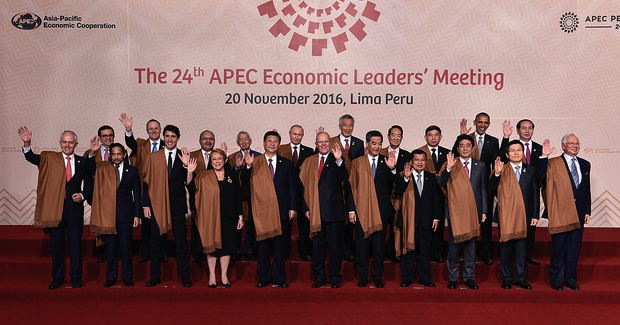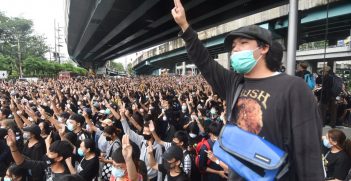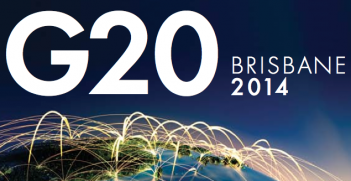What Next for Asia-Pacific Trade?

The annual APEC Summit concluded in Lima last week. It reflected an ongoing sentiment among APEC economies for building growth through regional free trade agreements. This contrasts with the darkening mood at recent G20 summits and the annual meetings for business leaders at Davos.
There is an increasingly myopic fixation that a global reversion to protectionism is underway. European commentators for example irrationally cited Brexit as a swing away from free trade. The real problem is simple: it is the consequences of protracted low growth.
The APEC Summit reconfirmed, as it has since its founding, its ambition to promote a free market region among Asia-Pacific economies. In Peru, it was agreed to continue examining how a Free Trade Agreement in Asia Pacific (FTAAP) might be considered. Discussion in the corridors was dominated by one question: how to deal with Trump’s declaration the US would not participate in the Trans-Pacific Partnership agreement.
It is undeniable the global economy is suffering economic sloth. The huge debt incurred to contain the Global Financial Crisis remains. The EU sits on a financial time bomb with a common EU currency but no common EU finance policy. Economists forecast the EU’s southern states will revolt. Meanwhile the EU’s attention is directed to a potentially socially destructive refugee crisis.
This is the mood of gloom which fosters fears of a reversion to protectionism in some fora, but not at the APEC table. APEC has been on a slow march since the prime ministers of Korea and Australia proposed in 1988 to build an open Asia-Pacific economy. APEC economies, including the US, Japan and China, account for 60 per cent of global GDP. When China decided in 2001 to regulate trade by applying World Trade Organization (WTO) rules, the ambition of building an open economy among all APEC economies became a practicality.
Four small members of APEC—New Zealand, Brunei, Chile and Singapore—initiated action to achieve this objective. They created their own mini-free trade system. It did not generate much increase in trade, but it laid a base for a bigger free trade agreement (FTA) among APEC economies.
The Obama administration ultimately took the cue. Sidetracked for a decade by military engagement in the Middle East, President Obama proposed an Asia-Pacific free trade agreement. The result is the draft Trans-Pacific Partnership Agreement (TPP). Australia, Vietnam, Malaysia, Korea, then Canada and Mexico signed on. China was suspicious the exercise had strategic as well as trade objectives.
A similar trade concept was proposed by ASEAN, at that time led by Indonesia. This was a regional trade agreement between ASEAN and the economies which had FTAs with it. This was dubbed the RCEP (Regional Comprehensive Economic Partnership Agreement). Australia, New Zealand, China, Korea and India, all with FTAs with ASEAN, participated. Key measures were not as comprehensive or as rigorous as those in the TPP draft agreement. ASEAN had already negotiated three agreements among its members to liberalise trade in goods, services and investment. But measures in its agreements to open markets for services and investment, the next step in building a regional Asian open market, remain largely unenacted.
The TPP agreement began life as an FTA umbrella over existing US FTAs. Vietnam and Malaysia were new participants. This picture changed dramatically when Japan’s prime minister, Shinzo Abe, committed to bring Japan into the TPP. Overnight, the TPP was no longer a “US plus” agreement. The concept of an FTA with Japan and the US (two of the world’s biggest economies) serving as the core mechanism to foster trans-Pacific open markets (particularly in services and investment) turned heads. Beijing saw this, as did others, and privately opened discussion with the US about Chinese participation.
The Obama administration diplomatically told Beijing it was not ready to adopt the sort of measures proposed in the agreement. China’s services industries were not open and it provided no guarantee of protection of foreign ownership, a critical security for foreign investors. It would be some time before that were the case.
Other APEC economies also expressed interest in joining the TPP—Thailand, the Philippines and Indonesia.
Donald Trump has been forthright that US participation in the TPP process will stop. He said that during the election campaign and shortly after victory. Yet US political history shows presidential election campaign promises do not necessarily become policy. He revoked his commitment during the campaign to see Hilary Clinton investigated after he won office.
Leaders of both houses of the US Congress have indicated interest in seeing a TPP agreement finished. They are Republicans and sympathetic to free trade. Congressional courtesy is to see new presidents set up their administrations and get on with the business of governing. Were the TPP to be considered afresh by the Trump administration it would not be until later in its term or more likely in a second term.
The concept of the TPP agreement does not lose credence if implementation is not early. It rests on a long-term strategy. As well, it is open to TPP members to unilaterally adopt the measures in the draft TPP into their own laws in advance if they so choose. This option was included in the communique issued by APEC leaders at Peru.
APEC has endorsed the concept of a Free Trade Agreement in Asia Pacific. This will occur, but not may be for a decade or two. There will be a succession of steps to reach that goal. The TPP or the measures negotiated in the draft agreement but adopted unilaterally are likely to serve as one of those steps, one way or another.
Alan Oxley is a former Australian Ambassador to the GATT (the predecessor of the WTO), Principal of ITS Global and Chair of the APEC Studies Centre at the Royal Melbourne Institute of Technology.
This article is published under a Creative Commons Licence and may be republished with attribution.





